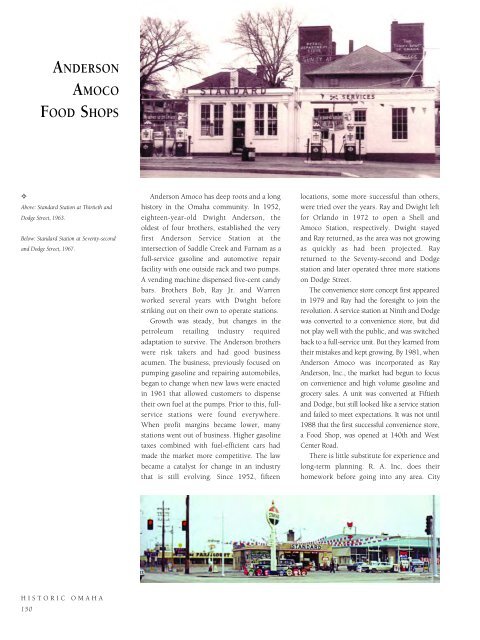Historic Omaha
An illustrated history of Omaha and the Douglas County area, paired with the histories of companies, families and organizations that make the region great.
An illustrated history of Omaha and the Douglas County area, paired with the histories of companies, families and organizations that make the region great.
You also want an ePaper? Increase the reach of your titles
YUMPU automatically turns print PDFs into web optimized ePapers that Google loves.
ANDERSON<br />
AMOCO<br />
FOOD SHOPS<br />
✧<br />
Above: Standard Station at Thirtieth and<br />
Dodge Street, 1963.<br />
Below: Standard Station at Seventy-second<br />
and Dodge Street, 1967.<br />
Anderson Amoco has deep roots and a long<br />
history in the <strong>Omaha</strong> community. In 1952,<br />
eighteen-year-old Dwight Anderson, the<br />
oldest of four brothers, established the very<br />
first Anderson Service Station at the<br />
intersection of Saddle Creek and Farnam as a<br />
full-service gasoline and automotive repair<br />
facility with one outside rack and two pumps.<br />
A vending machine dispensed five-cent candy<br />
bars. Brothers Bob, Ray Jr. and Warren<br />
worked several years with Dwight before<br />
striking out on their own to operate stations.<br />
Growth was steady, but changes in the<br />
petroleum retailing industry required<br />
adaptation to survive. The Anderson brothers<br />
were risk takers and had good business<br />
acumen. The business, previously focused on<br />
pumping gasoline and repairing automobiles,<br />
began to change when new laws were enacted<br />
in 1961 that allowed customers to dispense<br />
their own fuel at the pumps. Prior to this, fullservice<br />
stations were found everywhere.<br />
When profit margins became lower, many<br />
stations went out of business. Higher gasoline<br />
taxes combined with fuel-efficient cars had<br />
made the market more competitive. The law<br />
became a catalyst for change in an industry<br />
that is still evolving. Since 1952, fifteen<br />
locations, some more successful than others,<br />
were tried over the years. Ray and Dwight left<br />
for Orlando in 1972 to open a Shell and<br />
Amoco Station, respectively. Dwight stayed<br />
and Ray returned, as the area was not growing<br />
as quickly as had been projected. Ray<br />
returned to the Seventy-second and Dodge<br />
station and later operated three more stations<br />
on Dodge Street.<br />
The convenience store concept first appeared<br />
in 1979 and Ray had the foresight to join the<br />
revolution. A service station at Ninth and Dodge<br />
was converted to a convenience store, but did<br />
not play well with the public, and was switched<br />
back to a full-service unit. But they learned from<br />
their mistakes and kept growing. By 1981, when<br />
Anderson Amoco was incorporated as Ray<br />
Anderson, Inc., the market had begun to focus<br />
on convenience and high volume gasoline and<br />
grocery sales. A unit was converted at Fiftieth<br />
and Dodge, but still looked like a service station<br />
and failed to meet expectations. It was not until<br />
1988 that the first successful convenience store,<br />
a Food Shop, was opened at 140th and West<br />
Center Road.<br />
There is little substitute for experience and<br />
long-term planning. R. A. Inc. does their<br />
homework before going into any area. City<br />
HISTORIC OMAHA<br />
150
















